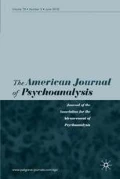Supported by The International Team of Ivan Ward, Ferenc Erös & Anna Kovács and Tom Keve.
In our First Special Issue we spoke about our London Conference: Sincerity and Freedom in 2013 (Szekacs-Weisz, 2014). Papers presented there were inspired by Ferenczi’s Clinical Diary and celebrated the centenary of the foundation of both the British and the Hungarian Societies—thus paying homage to the first 100 years of psychoanalysis.
Looking back at the turn of the last century, the time when psychoanalysis was born, from the very first decades of this millennium is an intellectual and emotional challenge, but it makes developmental tendencies visible. It also helps to ask questions and think about connections that are essential in making sense of our present and future. Perceiving these linkages also provide a chance of understanding what has been lost through the dramatic and traumatic experiences of the 20th century. We can see how new ideas became an integral part of the formative changes. They altered the face of the city, the interiors of public and private spaces, and the view of the world.
The quest for going beyond the surface that conceals the essential nature of things and to discover the world in its complex and confusing disharmonies and consonances became the challenge of those years. Experimenting with new modes of symbol formation and representation was being seen as part of this process. The new inquiry into the nature of the external and internal world is channeled through the prism of relatedness. In the psychoanalytic space meaning is created by the analytical couple together: the patient and the analyst are part of the internal experience and the interpretation of it. The creative process becomes a shared venture. All these factors cause mutative changes in our basic concepts regarding subject and object, body and mind, cause and effect, fact and fiction.
In our previous issue Sándor Ferenczi, his world and his ideas were in the focus: theoretical and methodological innovations were the main topics to be explored. Rediscovering the decisive role of Sincerity and Freedom in psychoanalytical thinking and clinical practice was a major message for us, working these days in different parts of the world. In the Second Volume we are getting closer to our time moving in an expanding analytical universe—observing it through the eyes of diverse generations. Here we are given the opportunity to look at historical mysteries like “Who is who in the Clinical Diary?”, the still somewhat hidden story of Elizabeth Severn and other patients, known by the code names that Ferenczi uses in his Diary, or the “virtual” group dynamics of patients, many from America, surrounding Sándor Ferenczi in Budapest.
On the pages of this issue we can follow not only the developmental stages regarding the concept of the child, but also the developmental stages of children in our living society and culture. To conclude this issue we present papers exploring the relationship between the ideas of Ferenczi, Carl Jung, Melanie Klein and Lacan.
We hope this collection of articles will make you feel revitalized in our thinking space where asking genuine questions is not less important than finding answers, where we can allow ourselves to be surprised and moved by well-known and novel ideas and where sharing the experience can be not only enriching and useful, but also a source of joy.
References
Szekacs-Weisz, J. (Ed.) (2014). First Special Issue, Sincerity and Freedom. London conference inspired by Ferenczi’s Clinical Diary. American Journal of Psychoanalysis, 74 (4).
Additional information
1Judit Szekacs-Weisz, Ph.D., is a bilingual psychoanalyst and psychotherapist, a member of both the British and the Hungarian Psychoanalytical Society.
2Address correspondence to Judit Szekacs-Weisz, Ph.D., Imago International, London, UK; e-mail: szekacsj@gmail.com
Rights and permissions
About this article
Cite this article
Szekacs-Weisz, J. In these pages…. Am J Psychoanal 75, 3–4 (2015). https://doi.org/10.1057/ajp.2014.61
Published:
Issue Date:
DOI: https://doi.org/10.1057/ajp.2014.61

